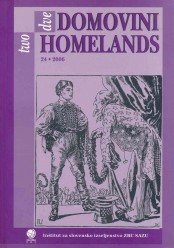SOME ASPECTS OF THE LIFE OF THE PRIMORJE IMMIGRANTS TO PREKMURJE BETWEEN THE TWO WORLD WARS
Keywords:
history, cultural history, emigration, immigration, Primorska refugees,, school history, Primorska emigrant societies, PrekmurjeAbstract
Prekmurje has been and to some extent is until the present day one of the most typical geographic regions of mass Slovene emigration. Less typical and considerably less numerous is especially in past historical periods the reverse process: the process of immigrating in Prekmurje. The first Slovenes that have in a larger number immigrated to Prekmurje were undoubtedly the refugees from Primorska who after 1918 fled mainly from the Italian denationalisation violence, particularly after its aggravation after the fascist takeover of power. The Isonzo front during World War I and even more the above mentioned, and the denationalisation measures of the Italian authorities, banished from their homes over 100.000 Slovenes from Primorje and Istrian Croats of whom the majority after 1918 resorted to the newly founded South Slav state, and the rest mainly to Western Europe and South America, particularly Argentina. In the first period, they as mainly liberally and Yugoslav centralistic oriented, were given work in not too popular state vocations (thus, in the police, the customs etc.); later, during the economic crisis, the local population considered them unwanted competition in the struggle for the scant everyday bread. The word “Primorec” meant in many an environment of the homeland a true verbal abuse.
To the Yugoslav state in 1919 annexed Prekmurje offered some possibilities for the survival of the above mentioned emigrants from Primorska, above all teachers who with their Yugoslav and liberal orientation resolutely and to a certain extent as a foreign body intervened in the there, with a specific historical development defined social, religious, economic and cultural environment. The state authorities settled near Dolnja Lendava in Petišovci, Benica and Pince several tens of emigrant peasant families from Primorje and Istria. All the mentioned aspects of the life of the Primorje immigrants and refugees are merely briefly presented in the treatise.
Downloads
References
Kokolj, Miroslav, Horvat, Bela, Prekmursko šolstvo od začetka reformacije do zloma nacizma, Pomurska založba, Murska Sobota 1977, str. 356.
Mihael Kuzmič, Slovenski izseljenci iz Prekmurja v Betlehemu v ZDA 1893-1924, Naselitev in njihove zgodovinske, socialne, politične, literarne in verske dejavnosti, Inštitut za slovensko izseljenstvo ZRC SAZU, Založba ZRC SAZU, Ljubljana 2001, 325 str. Migracije 2.
M. Kiraly, M. Jutka, Prekmurski Primorci niso prišleki. - Nedelo, Ljubljana V/l 999, št. 37 (12. 9.), str. 4.
Pahor, Minka, Primorski učitelji 1914-1941. Prispevek k proučevanju zgodovine slovenskega šolstva na Primorskem, Trst 1994, 543 str.
Vovko, Andrej, Organizacije jugoslovanskih emigrantov iz Julijske krajine do leta 1933, Zgodovinski časopis, Ljubljana, 32/1978, 449-473.
Vovko, Andrej, Delovanje Zveze jugoslovanskih emigrantov iz Julijske krajine v letih 1933-1940, Zgodovinski časopis, Ljubljana, 33/1979, 67-102.
Vovko, Andrej, Mal položi dar ... Portret slovenske narodnoobrambne šolske organizacije Družbe sv. Cirila in Metoda 1885-1918, Slovenska matica, Ljubljana 1994, 237 str.
Downloads
Published
How to Cite
Issue
Section
License

This work is licensed under a Creative Commons Attribution-NonCommercial-NoDerivatives 4.0 International License.
Authors guarantee that the work is their own original creation and does not infringe any statutory or common-law copyright or any proprietary right of any third party. In case of claims by third parties, authors commit their self to defend the interests of the publisher, and shall cover any potential costs.
More in: Submission chapter





